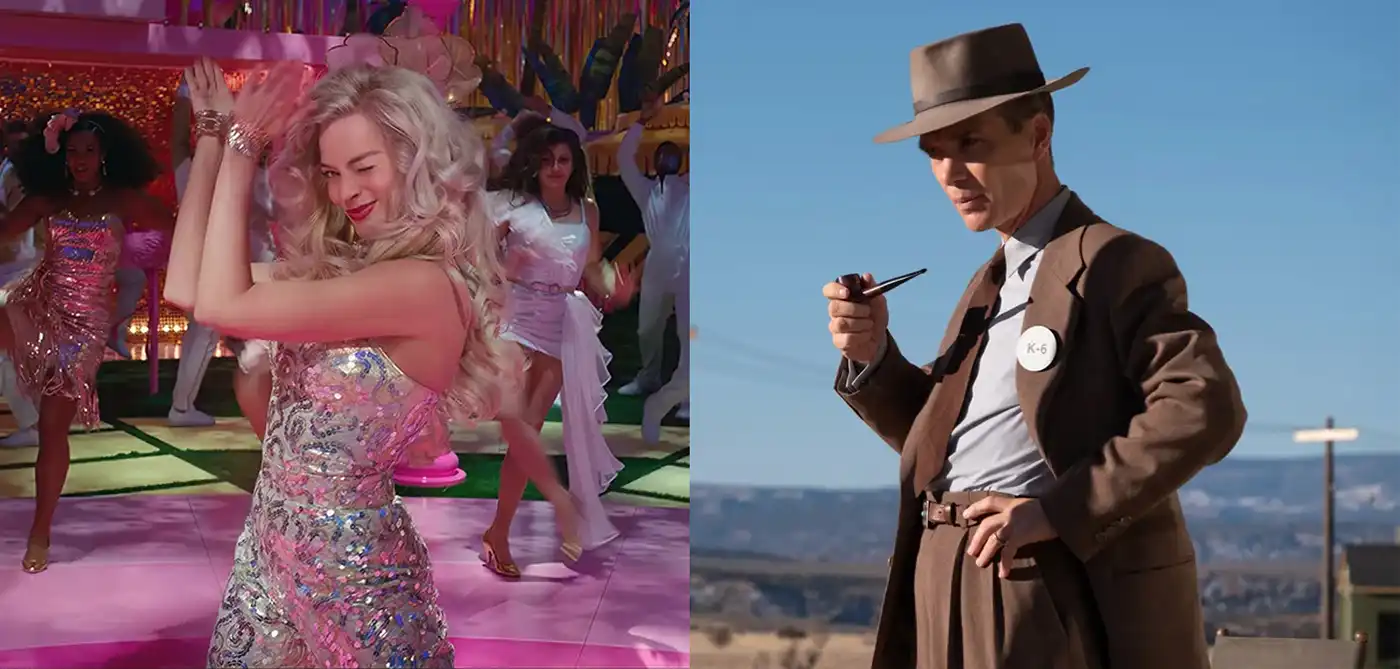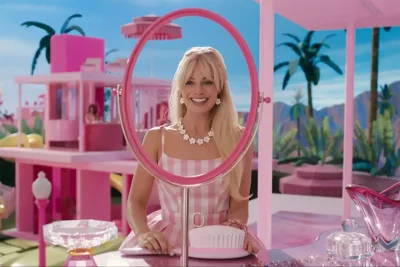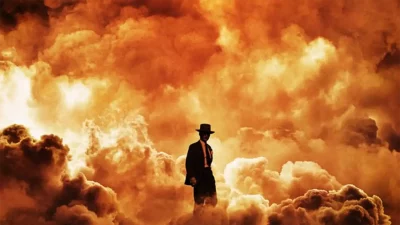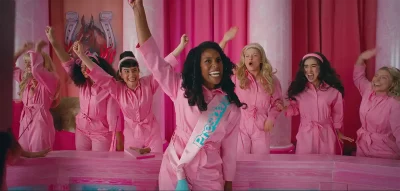
Barbenheimer: The Double Feature Digging Theaters Out of Their Grave
Film
When word came out last year that Barbie and Oppenheimer would both debut on July 21,2023, it sent the film community into a frenzy. The same-day premiere (rumored to be a result of studio wars) caused visceral panic. But worry ultimately turned into opportunity, a problem with the same solution as a beloved taco shell advertisement on the difficulty of choice: Why not both? Thus, the double feature was born, and it was deemed “Barbenheimer.”

The chronically online are already familiar with the film community’s commitment to the cause with Barbenheimer. There are Barbenheimer t-shirts and custom costumes and itineraries. Someone out there is probably rolling their eyes, asking, “Why does every cultural experience need to be monetized?” I don’t have an adequate answer. I do have one for Barbenheimer: because it’s fun. Somewhere along the way, we forgot media is designed for entertainment and enjoyment rather than a reflection of our taste or an opportunity to explore new themes or mediums. The duality of Barbenheimer represents an invitation to engage with media in ways that don’t force our interests into a box.
My friends and I started planning for Barbenheimer a year in advance, and I know many people who did the same. Anticipation built for months after watching interview after interview with the cast and crew, and it became unanimously understood that this would be the best day of the summer—we would be part of a cultural monument that would rekindle the film industry. We initially intended to catch the double feature at Broadway Centre Cinemas, starting with the dread and intellect of Oppenheimer only to be brought back from the ashes by Barbie’s vibrance. But when an interview with Director Christopher Nolan circulated about how he specifically created the film for IMAX viewing, we instead purchased tickets for the afternoon IMAX showing at the Megaplex Theatres at Valley Fair Mall.

Seeing Oppenheimer in a sold-out IMAX viewing was a revelation. Nolan (The Dark Knight, Inception, Interstellar), who is notorious for his use of practical effects, recreated a mushroom cloud in Oppenheimer without using CGI and utilized overwhelming silence throughout the film only to then welcome grandiose sounds of explosions. The suspense and tension Oppenheimer built made me feel like I was playing a game of hide-and-seek with the consequences of a nuclear world. The character representing Danish physicist Niels Bohr describes the ramifications of the Manhattan Project best: “This isn’t a new weapon. It’s a new world.”
The full effect of the film wouldn’t have been possible without Cillian Murphy (Peaky Blinders, Inception, Dunkirk) starring as J. Robert Oppenheimer. Nolan wrote the script in first-person for Murphy based on Oppenheimer’s biography American Prometheus, and Murphy delivered a performance that subtly sneaks you into the thoughts and feelings of an elusive man, allowing the audience to formulate their own opinions of the character rather than have one created for them. Applause came after the credits began to roll, bu there was first an overwhelming silence. I wondered if everyone had the same lump in their throat as if they had just attended a funeral.
With only two hours to spare between viewings, my party headed to Copper Common to order oysters from Mexico and share a bottle of Orange Früg from MYSA Natural Wine while we discussed Murphy’s portrayal of a brilliant, conflicted man. The restaurant was inundated with filmgoers. The table next to us was also dissecting Oppenheimer, and every new patron to walk in the door was dressed head-to-toe in their best Barbie attire. A collective joy filled the room. We clearly all signed up for the same experience.
On the night of Barbenheimer at Broadway Centre Cinemas, you weren’t walking into a theater, you were walking into a party. One by one, every person dressed in pink or Barbenheimer garb climbed into a photo prop made to look like a life-sized Barbie box to pose as the Barbie they identify with.. Chatter filled the air, and people scrambled to find seats: one woman arrived a few minutes late and walked up and down the aisle in what appeared to be a wedding gown. When the lights went down and the Barbie logo came on screen, the crowd went wild—they stayed wild for the entire film.

Margot Robbie (The Wolf of Wall Street, I, Tonya, Once Upon a Time in Hollywood)stars as “stereotypical Barbie” in the film. Robbie was initially the person to first receive rights for Barbie from its manufacturing company, Mattel, and she sought out Director Greta Gerwig in order to run far away from the typical “Barbie” story people might expect. Written alongside her creative and life partner Noah Baumbach (White Noise, Frances Ha, Marriage Story), Gerwig perfectly captures the challenges of identity and change in Barbie. That’s no surprise given her Rolodex of bittersweet and widely adored films centered on women and their relationships with themselves and those around them. Nostalgia is present in Barbie, and naturally for Gerwig, there are also heavy mother-daughter themes throughout. There’s even a beautiful montage of real home videos from friends and family of the cast and crew in an ode to girlhood.
The intense emotional moments didn’t take away from how fun Barbie is—the audience erupted with laughter thanks to its whip-smart dialogue and over-the-top performances. Ryan Gosling (La La Land, Drive, The Notebook), who gave us one of his most impressive comedic performances to date as Ken, and America Ferrera (Ugly Betty, The Sisterhood of the Traveling Pants, Superstore), who delivered an equally heart-wrenching and empowering monologue on womanhood as a mother longing for connection between herself and her daughter, both steal the show and exhibit a mastery of their craft. Barbie is a hoot and a holler, and I hope everyone got to sit next to their best friend and hold their hand as they laughed and cried until the credits rolled. When the lights came up, the audience gave not only applause but a rallying cry. Leaving Barbie felt like leaving a concert.

One might call the contrast between Oppenheimer and Barbie—the grayscale versus oversaturation, the academic versus colloquial script—emotional whiplash. To me, the Barbenheimer experience represents dynamism. In a divisive world, we’re expected to pick a side—if you like pink, you can’t like black. Barbenheimer gives us permission to enjoy two polarizing experiences and appreciate their differences. I respect both Gerwig and Nolan for leaning into traditions of film, but I’m more grateful for the directors’ original portrayals of the various ways we’re capable of understanding and relating to our human complexities. They made going to the theater exciting again.
It wouldn’t surprise me if a lot of people perceive Barbenheimer as rooted in competition: the better film shall take home the most awards or the most money. Although I’m elated for Gerwig that Barbie is now the biggest box office opening of the year and the greatest opening of all time for a female director, I still don’t think most people who experienced both films are forcing comparisons. The success of both films is driving a cultural and creative reset, and those who participated in Barbenheimer can look back and say they were the ones who always believed that film was not dead.
Read reviews of Barbie and Oppenheimer:
Film Review: Barbie
Film Review: Oppenheimer